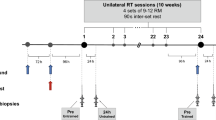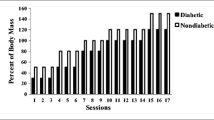Abstract
Skeletal muscle is the source of pro- and anti-inflammatory cytokines, and recently, it has been recognized as an important source of interleukin 6 (IL-6), a cytokine that exerts inhibitory effects on several pro-inflammatory cytokines. Although dynamic chronic resistance training has been shown to produce the known “repeated bout effect”, which abolishes the acute muscle damage, performing of high-intensity resistance training has been regarded highly advisable, at least from the hypertrophy perspective. On the other hand, a more therapeutic, “non-damaging” resistance training program, mainly composed of concentric forces, low frequency/low volume of training, and the same exercise, could theoretically benefit the muscle when the main issue is to avoid muscle inflammation (as in the treatment of several “low-grade” inflammatory diseases) because the acute effect of each resistance exercise session could be diminished/avoided, at the same time that the muscle is still being overloaded in a concentric manner. However, the benefits of such “less demanding” resistance training schedule on the muscle inflammatory profile have never been investigated. Therefore, we assessed the protein expression of IL-6, TNF-α, IL-10, IL-10/TNF-α ratio, and HSP70 levels and mRNA expression of SCFβ-TrCP, IL-15, and TLR-4 in the skeletal muscle of rats submitted to resistance training. Briefly, animals were randomly assigned to either a control group (S, n = 8) or a resistance-trained group (T, n = 7). Trained rats were exercised over a duration of 12 weeks (two times per day, two times per week). Detection of IL-6, TNF-α, IL-10, and HSP70 protein expression was carried out by western blotting and SCFβ-TrCP (SKP Cullin F-Box Protein Ligases), a class of enzymes involved in the ubiquitination of protein substrates to proteasomal degradation, IL-15, and TLR-4 by RT-PCR. Our results show a decreased expression of TNF-α and TLR4 mRNA (40 and 60%, respectively; p < 0.05) in the plantar muscle from trained, when compared with control rats. In conclusion, exercise training induced decreased TNF-α and TLR-4 expressions, resulting in a modified IL-10/TNF-α ratio in the skeletal muscle. These data show that, in healthy rats, 12-week resistance training, predominantly composed of concentric stimuli and low frequency/low volume schedule, down regulates skeletal muscle production of cytokines involved in the onset, maintenance, and regulation of inflammation.

Similar content being viewed by others
References
Benjamin IJ, McMillan DR (1998) Stress (heat shock) proteins: molecular chaperones in cardiovascular biology and disease. Circ Res 83:117–132
Busquets S, Figueras MT, Meijsing S, Carbo N, Quinn LS, Almendro V, Argiles JM, Lopez-Soriano FJ (2005) Interleukin-15 decreases proteolysis in skeletal muscle: a direct effect. Int J Mol Med 16:471–476
Carvalho CR, Thirone AC, Gontijo JA, Velloso LA, Saad MJ (1997) Effect of captopril, losartan, and bradykinin on early steps of insulin action. Diabetes 46:1950–1957
Chan MH, Carey AL, Watt MJ, Febbraio MA (2004) Cytokine gene expression in human skeletal muscle during concentric contraction: evidence that IL-8, like IL-6, is influenced by glycogen availability. Am J Physiol Regul Integr Comp Physiol 287:R322–R327
Chen TC, Hsieh SS (2001) Effects of a 7-day eccentric training period on muscle damage and inflammation. Med Sci Sports Exerc 33:1732–1738
Frost RA, Nystrom GJ, Jefferson LS, Lang CH (2007) Hormone, cytokine, and nutritional regulation of sepsis-induced increases in atrogin-1 and MuRF1 in skeletal muscle. Am J Physiol Endocrinol Metab 292:E501–E512
Fujiwara N, Kobayashi K (2005) Macrophages in inflammation. Curr Drug Targets Inflamm Allergy 3:281–286
Glickman MH, Ciechanover A (2002) The ubiquitin-proteasome proteolytic pathway: destruction for the sake of construction. Physiol Rev 82:373–428
Glover JR, Lindquist S (1998) Hsp104, Hsp70, and Hsp40: a novel chaperone system that rescues previously aggregated proteins. Cell 94:73–82
Grabstein KH, Eisenman J, Shanebeck K, Rauch C, Srinivasan S, Fung V, Beers C, Richardson J, Schoenborn MA, Ahdieh M (1994) Cloning of a T cell growth factor that interacts with the beta chain of the interleukin-2 receptor. Science 264:965–968
Huey KA, McCall GE, Zhong H, Roy RR (2007) Modulation of HSP25 and TNF-alpha during the early stages of functional overload of a rat slow and fast muscle. J Appl Physiol 102:2307–2314
Kanayama A, Seth R, Sun L et al (2004) TAB 2 and TAB 3 activate the NF-kappaB pathway through binding to polyubiquitin chains. Mol Cell 15:535–548
Klitgaard H (1988) A model for quantitative strength training of hindlimb muscles of the rat. J Appl Physiol 64:1740–1745
Lambert CP, Wright NR, Finck BN, Villareal DT (2008) Exercise but not diet-induced weight loss decreases skeletal muscle inflammatory gene expression in frail obese elderly persons. J Appl Physiol 105:473–478
Lira FS, Koyama CH, Yamashita AS, Rosa JC, Zanchi NE, Batista ML Jr, Seelaender M (2009a) Chronic exercise decreases cytokines production in healthy rat skeletal muscle. Cell Biochem Funct 27:458–461
Lira FS, Rosa JC, Yamashita AS, Koyama CH, Batista ML Jr, Seelaender M (2009b) Endurance training induces depot-specific changes in IL-10/TNF-alpha ratio in rat adipose tissue. Cytokine 45:80–85
Lira FS, Rosa JC, Zanchi NE, Yamashita AS, Lopes RD, Lopes AC, Batista ML Jr, Seelaender M (2009c) Regulation of inflammation in the adipose tissue in cancer cachexia: effect of exercise. Cell Biochem Funct 27:71–75
Mathur N, Pedersen BK (2008) Exercise as a mean to control low-grade systemic inflammation. Mediators Inflamm 2008:109502
McFarlin BK, Flynn MG, Campbell WW, Stewart LK, Timmerman KL (2004) TLR4 is lower in resistance-trained older women and related to inflammatory cytokines. Med Sci Sports Exerc 36:1876–1883
Moldoveanu AI, Shephard RJ, Shek PN (2001) The cytokine response to physical activity and training. Sports Med 31:115–144
Morton JP, MacLaren DP, Cable NT, Bongers T, Griffiths RD, Campbell IT, Evans L, Kayani A, McArdle A, Drust B (2006) Time course and differential responses of the major heat shock protein families in human skeletal muscle following acute nondamaging treadmill exercise. J Appl Physiol 101:176–182
Nieman DC, Davis JM, Henson DA, Walberg-Rankin J, Shute M, Dumke CL, Utter AC, Vinci DM, Carson JA, Brown A, Lee WJ, McAnulty SR, McAnulty LS (2003) Carbohydrate ingestion influences skeletal muscle cytokine mRNA and plasma cytokine levels after a 3-h run. J Appl Physiol 94:1917–1925
Nieman DC, Davis JM, Brown VA, Henson DA, Dumke CL, Utter AC, Vinci DM, Downs MF, Smith JC, Carson J, Brown A, McAnulty SR, McAnulty LS (2004) Influence of carbohydrate ingestion on immune changes after 2 h of intensive resistance training. J Appl Physiol 96:1292–1298
Norenberg KM, Fitts RH (2004) Contractile responses of the rat gastrocnemius and soleus muscles to isotonic resistance exercise. J Appl Physiol 97:2322–2332
Oishi Y, Taniguchi K, Matsumoto H, Ishihara A, Ohira Y, Roy RR (2002) Muscle type-specific response of HSP60, HSP72, and HSC73 during recovery after elevation of muscle temperature. J Appl Physiol 92:1097–1103
Paulsen G, Vissing K, Kalhovde JM, Ugelstad I, Bayer ML, Kadi F, Schjerling P, Hallén J, Raastad T (2007) Maximal eccentric exercise induces a rapid accumulation of small heat shock proteins on myofibrils and a delayed HSP70 response in humans. Am J Physiol Regul Integr Comp Physiol 293:R844–R853
Pedersen BK, Saltin B (2006) Evidence for prescribing exercise as therapy in chronic disease. Scand J Med Sci Sports 16:3–63
Petersen AMW, Pedersen BK (2005) The anti-inflammatory effect of exercise. J Appl Physiol 98:1154–1162
Pretolani M (1999) Interleukin-10: an anti-inflammatory cytokine with therapeutic potential. Clin Exp Allergy 29:1164–1171
Rosa Neto JC, Lira FS, Oyama LM, Zanchi NE, Yamashita AS, Batista ML Jr, Oller do Nascimento CM, Seelaender M (2009) Exhaustive exercise causes an anti-inflammatory effect in skeletal muscle and a pro-inflammatory effect in adipose tissue in rats. Eur J Appl Physiol 106(5):697–704
Schindler R, Mancilla J, Endres S, Ghorbani R, Clark SC, Dinarello CA (1990) Correlations and interactions in the production of interleukin-6 (IL-6), IL-1, and tumor necrosis factor (TNF) in human blood mononuclear cells: IL-6 suppresses IL-1 and TNF. Blood 75:40–47
Schottelius AJG, Mayo MW, Sartor RB, Baldwin AS Jr (1999) Interleukin-10 signaling blocks inhibitor of kappa B kinase activity and nuclear factor kappa B DNA binding. J Biol Chem 274:31868–31874
Serrano AL, Baeza-Raja B, Perdiguero E, Jardí M, Muñoz-Cánoves P (2008) Interleukin-6 is an essential regulator of satellite cell-mediated skeletal muscle hypertrophy. Cell Metab 7:33–44
Starkie R, Ostrowski SR, Jauffred S, Febbraio M, Pedersen BK (2003) Exercise and IL-6 infusion inhibit endotoxin-induced TNF-alpha production in humans. FASEB J 17:884–886
Steensberg A, van Hall G, Osada T, Sacchetti M, Saltin B, Klarlund Pedersen B (2000) Production of interleukin-6 in contracting human skeletal muscles can account for the exercise-induced increase in plasma interleukin-6. J Physiol 529:237–242
Vieira RP, Claudino RC, Duarte AC, Santos AB, Perini A, Faria Neto HC, Mauad T, Martins MA, Dolhnikoff M, Carvalho CR (2007) Aerobic exercise decreases chronic allergic lung inflammation and airway remodeling in mice. Am J Respir Crit Care Med 176:871–877
Willoughby DS, McFarlin B, Bois C (2003) Interleukin-6 expression after repeated bouts of eccentric exercise. Int J Sports Med 24:15–21
Wirth O, Gregory EW, Cutlip RG, Miller GR (2003) Control and quantitation of voluntary weight-lifting performance of rats. J Appl Physiol 95:402–412
Zanchi NE, Lancha AH Jr (2008) Mechanical stimuli of skeletal muscle: implications on mTOR/p70s6k and protein synthesis. Eur J Appl Physiol 102(3):253–263
Zanchi NE, de Siqueira Filho MA, Lira FS, Rosa JC, Yamashita AS, de Oliveira Carvalho CR, Seelaender M, Lancha AH Jr (2009) Chronic resistance training decreases MuRF-1 and Atrogin-1 gene expression but does not modify Akt, GSK-3beta and p70S6K levels in rats. Eur J Appl Physiol 106:415–423
Zanchi NE, Lira FS, Seelaender M, Lancha AH Jr (2010) Experimental chronic low-frequency resistance training produces skeletal muscle hypertrophy in the absence of muscle damage and metabolic stress markers. Cell Biochem Funct 28:1–7
Acknowledgments
We gratefully acknowledge the technical assistance of Emilia Ribeiro. This study (Grant no. 08/51090-1) was supported by the Brazilian Funding Agency (FAPESP—Fundação de Amparo à Pesquisa do Estado de São Paulo).
Author information
Authors and Affiliations
Corresponding author
Additional information
Communicated by Susan Ward.
Rights and permissions
About this article
Cite this article
Zanchi, N.E., Lira, F.S., de Siqueira Filho, M.A. et al. Chronic low frequency/low volume resistance training reduces pro-inflammatory cytokine protein levels and TLR4 mRNA in rat skeletal muscle. Eur J Appl Physiol 109, 1095–1102 (2010). https://doi.org/10.1007/s00421-010-1456-0
Accepted:
Published:
Issue Date:
DOI: https://doi.org/10.1007/s00421-010-1456-0




